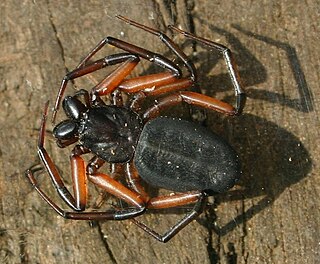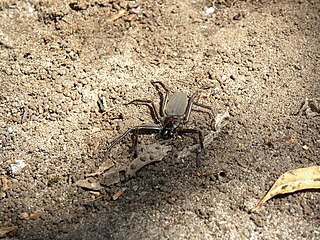
Cithaeronidae is a small family of araneomorph spiders first described by Simon in 1893 Female Cithaeron are about 5 to 7 millimetres long, males about 4 millimetres (0.16 in).

Gallieniellidae is a family of spiders first described by J. Millot in 1947. It was originally thought to be endemic to Madagascar until species were also found in southern Kenya, northeastern Argentina, and Australia. Drassodella was transferred from the family Gnaphosidae in 1990. They are suspected to be specialized in ant-preying.

Trochanteriidae is a family of spiders first described by Ferdinand Karsch in 1879 containing about 52 species in6 genera. Most are endemic to Australia though Doliomalus and Trochanteria are from South America and Plator is from Asia. Platyoides species exist in southern and eastern Africa, Madagascar, and the Canary Islands with one species, P. walteri, introduced to Australia.

The Dionycha are a clade of spiders (Araneomorphae:Entelegynae), characterized by the possession of two tarsal claws with tufts of hairs (setae) beside them, which produce strong adhesion, enabling some species to climb glass. The circumscription of the group has varied widely; a 2021 analysis resulted in about 20 families, including Salticidae, Gnaphosidae, and Clubionidae.

The Gnaphosoidea or gnaphosoids are a superfamily of araneomorph spiders with seven families. A 2014 study did not find the group to be monophyletic.

Platyoides is a genus of spiders belonging to the family Trochanteriidae. Its members are known as scorpion spiders and are found in sub-Saharan Africa and its islands, Madagascar, Réunion, Aldabra and the Canary Islands.
Boolathana is a genus of spiders in the family Trachycosmidae found in western Australia. There are two species in the genus, Boolathana mainae and Boolathana spiralis. It is named after Boolathana Station, a pastoral lease near where the first specimen was found.
Boolathana spiralis is one of two species of western Australian spiders in the family Trochanteriidae. The name refers to the coiled tip of the middle apophysis, one of the defining characteristics of the species. It is mostly red to brown, the colour fading from dark on the top front to gray in the sides and bottom.
Inthaeron is a monotypic genus of Asian araneomorph spiders in the family Cithaeronidae, containing the single species, Inthaeron rossi. It was first described by Norman I. Platnick in 1991, and has only been found in India. Females can be distinguished from those of its sister genus, Cithaeron, by the arrangement of cylindrical gland spigots on the posterior median spinnerets, appearing in two rows rather than in clusters. The name is derived from "India", the country it was first found in, and "Cithaeron", the name of the other genus of Cithaeronidae.
Austrammo is a genus of Australian Ground spiders first described by Norman I. Platnick in 2002.
Peeto is a monotypic genus of Australian araneomorph spiders in the family Trachycosmidae containing the single species, Peeto rodmani. It was first described by Norman I. Platnick in 2002, and has only been found in Australia.
Questo is a monotypic genus of Australian araneomorph spiders in the family Trachycosmidae containing the single species, Questo annuello, named after where it was found, Annuello, Victoria. It was first described by Norman I. Platnick in 2002, and has only been found in Australia.
Centroina is a genus of Australian white tailed spiders that was first described by Norman I. Platnick in 2000.
Lamponova is a monotypic genus of South Pacific white tailed spiders containing the single species, Lamponova wau. It was first described by Norman I. Platnick in 2000, and has only been found in Papua New Guinea and in Australia.
Longepi is a genus of Australian white tailed spiders that was first described by Norman I. Platnick in 2000.
Pseudolampona is a genus of Australian white tailed spiders that was first described by Norman I. Platnick in 2000.

Queenvic is a genus of Australian white tailed spiders that was first described by Norman I. Platnick in 2000.

Morebilus is a genus of spiders in the family Trachycosmidae found in southern and western Australia, first described by Norman I. Platnick in 2002. These are large spiders, with the carapace of males ranging from 10 to 16 millimeters and those of females ranging from 10 to 24 millimeters. They look similar to members of Rebilus, especially the spinneret and tarsal claw, but members of this genus have an inclined lip at the anterior edge of the sternum as well as a pair of enlarged sclerites on the coxal glands.
Oreo is a genus of Australian araneomorph spiders in the family Trachycosmidae, and was first described by Norman I. Platnick in 2002. The name derives from the Oreo cookie. The type species has a black and white abdomen, although such coloration is common among gallieniellids.
Neato is a genus of Australian araneomorph spiders in the family Trachycosmidae, and was first described by Norman I. Platnick in 2002.






